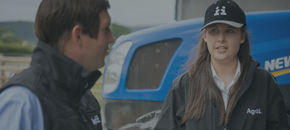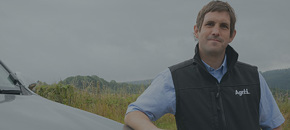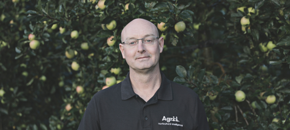Future-Proofing Forage
Future-Proofing Forage Against Weather Extremes
As UK farmers continue to face increasingly unpredictable and extreme weather patterns, building resilience into forage systems is a necessity.
In this edition of Tramlines, we sat down with Ben Lowe, Agrii’s National Forage Product Manager, and Amy Hardwick, Agrii’s Sustainability and Environmental Services Manager, to explore what can be done now and in the longer term to safeguard forage production.
This Episode Features:

Tony Smith
Your Tramlines Host

Ben Lowe
National Forage Product Manager

Amy Hardwick
Sustainability & Environmental Services Manager
What's the Current Outlook for Forage?
According to Ben Lowe, while the wet winter of 2023 was a challenge, the 2024 growing season has presented its own issues due to low rainfall and cooler nights, especially in spring.
These conditions have restricted forage growth and establishment, leaving some areas, particularly parts of England and Wales, facing serious shortfalls in production heading into winter.
Amy Hardwick adds that this is part of a broader pattern of unpredictability, affecting both livestock and arable operations.
From mixed yields at harvest to shifting environmental subsidy schemes and grant competitiveness, farmers are feeling squeezed from all angles, financially and practically.
Changing Weather Patterns Are the New Norm
Amy encourages growers to shift their mindset. What once might have been a “1-in-20” extreme weather year is now closer to “2-in-5”. Instead of hoping for better seasons, she argues that farmers should start building resilience into their systems as standard.
“With challenges come new opportunities… it’s about doing things slightly differently, not just waiting for things to improve.”
Reseeding: A Simple First Step to Build Resilience
Ben highlights the importance of new grass reseeds in boosting drought resilience. Compared to older leys, new seeds offer:
- Better rooting structure
- Increased nutrient uptake
- Greater tolerance of dry spells
Including legumes such as red and white clovers further enhances drought tolerance while fixing nitrogen and boosting forage protein content.
Forage Rye: A Reliable Bridge Crop After Maize
One of Ben’s key recommendations is forage rye, especially as a follow-on from early maize harvests. With maize typically coming off in September or October, forage rye can be:
- Direct-drilled post-harvest
- Grown through winter with minimal dormancy
- Harvested in spring to extend forage supply
“It just keeps growing,” says Ben. “It’s simple to establish and doesn’t sit dormant over winter like other crops might.”
Weighing Up Your Options: Westwolds, Italians, or Rye?
Ben explains the three most common post-maize options:
- Westwolds ryegrass - cost-effective but less winter-hardy
- Italian ryegrass - more durable and versatile
- Forage rye - strong winter growth, minimal risk
Is Seed Available?
Yes, but act quickly. Ben notes growing interest in forage rye and confirms that Agrii has invested in producing more UK-grown seed to meet demand. Farmers are encouraged to plan ahead and secure seed early.
What Do We Mean by ‘Resilience’?
Amy breaks resilience into two key areas:
- Economic resilience: protecting income, improving ROI
- Environmental resilience: improving soil structure, crop tolerance
Biodiversity Net Gain: A Longer-Term Option
For underperforming paddocks or marginal land, Biodiversity Net Gain (BNG) may offer a new income stream. This private sector initiative allows farmers to rent land for habitat improvement over 30-year agreements, generating guaranteed income and often including external management.
Collaboration and Rotation Flexibility
Ben suggests that forage resilience isn’t just about what you grow, but how you grow it and who you grow it with:
- Integrating forage into arable rotations
- Partnering with neighbours for grazing access
- Using forage brassicas to extend grazing
Top Tips from the Experts
Ben Lowe
“The worst thing you can do now is nothing. We’ve got 12 weeks, make a plan, consider reseeding, and don’t rely on ‘green grass’ that may just be weeds.”
Amy Hardwick
“Accept that these weather extremes are the new normal. Use it as a chance to think differently, look at your soil, your land use, and the opportunities to build long-term resilience.”
Support from Agrii
Whether you're considering reseeding, forage rotations, or environmental diversification, Agrii’s technical and environmental teams are here to help.
📞 Speak to your local agronomist
📥 Or contact us via our website
Explore more about maize, forage, and sustainability at:
👉 agrii.co.uk/our-services/tools-resources/documents
Related episodes
Maize Matters: Ensure your variety selection is in Harmony
Episode 16The Importance of Analysing Soil and Plant Health
Making the Most of Home Grown Forage
Episode 24Forage Trial and Biogas Plant Results
Season 2, episode 28Hybrid Rye: A Solution to Today's Farming Challenges
Rethinking Grassland Fertiliser as Animal Feed
Episode 3Getting the Most From Your Maize
Taking Stock of Understanding your Forage
Never miss an episode of Tramlines








